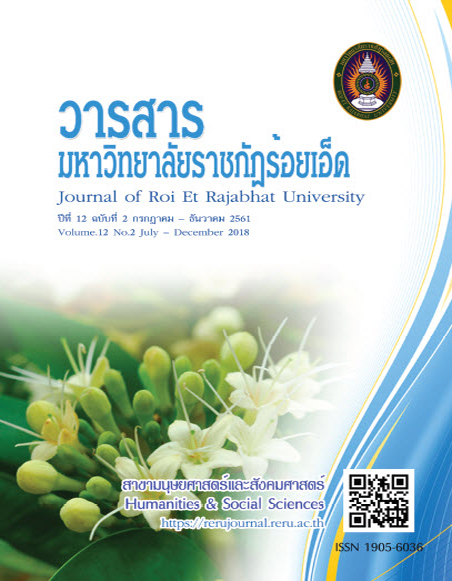Community Participation: Food Security Strengthening Through Nong Han Watershed Forest Management, Sakhonakorn Province
Keywords:
participation, food security, watershed forestAbstract
This research article aims to analyze relevant factors related to food security strengthening under participatory watershed forestmanagement. Qualitative research methods were used including observation, semi-structure interview, focused group discussion, and descriptive analysis. Site selection was purposive to villages alongNamPung river called Lup Lao community, and the target groups were community organizations, forest users within and outside of the community, community leaders as well as representatives from relevant organizations. The research found Lup Lao community has 5 plots of community forest with total area of 5,654 rai, located in Dong ChomPhuPhan – Pa Dong Kra Cher forest reserve area and in the public land. However, the villagers could still enjoy seasonal forest products which sufficient for their household consumptions and accounted for 30 percent of the households’ annual food consumption. In addition, some households could sell the forest products and earn additional income. The key factors contributed to food security were 1) having common goal in managing each community forest plot among members, 2) agroforestry development in the community forests and farm’s edge, 3) community awareness on sustainable use of forest resources at the household and community levels, 4) growing economic crops for additional income, 5) development of common agreements and rules towards the implementation, 6) increasing of forest area and biodiversity, as well as 7) supports from relevant organizations. These are all key factors to strengthen food security under the context of participatory watershed forest management and can be scale up to strengthen food security in other watershed areas.
References
ธงชัย สอนสูญ. (2560). โครงสร้างกลุ่มเยาวชนจิตอาสา ต้นกล้าคุณธรรม ปี 2560. เอกสารเย็บเล่มชุมชนบ้านหลุบเลา ตำบลหลุบเลา อำเภอภูพาน จังหวัดสกลนคร
นนทกานต์ จันทร์อ่อน. (2557). “ความมั่นคงทางอาหารของประเทศไทย” (Thailand Food Security). สำนักวิชาการ สำนักงานเลขาธิการวุฒิสภา, 4(2), 1-27.
ภัชราภรณ์ สาคำ, ชัยมงคล โชติวัฒนตระกูล และกิติมา ขุนทอง. (2558). การศึกษาองค์ความรู้ด้านจัดการป่า และการพัฒนาความหลากหลายทางชีวภาพอย่างมีส่วนร่วมในพื้นที่ป่าต้นน้ำหนองหาร จังหวัดสกลนคร. รายงานการวิจัย ฉบับสมบูรณ์. สำนักงานคณะกรรมการการอุดมศึกษา (สกอ.)
ภัชราภรณ์ สาคำ, ดุสิตา กระวานชิด และพงษ์ศักดิ์ ฐานสินพล. (2559). การศึกษารูปแบบการมีส่วนร่วมของชุมชน ในการจัดการป่าเพื่อสร้างความมั่นคงทางอาหาร เขตพื้นที่ป่าต้นน้ำหนองหาร จังหวัดสกลนคร. รายงานการวิจัยฉบับสมบูรณ์. สำนักงานคณะกรรมการการอุดมศึกษา (สกอ.)
ภัชราภรณ์ สาคำ, ปฏิมาภรณ์ กังวานศรีเพชร และพงษ์ศักดิ์ ฐานสินพล. (2560). การพัฒนาศักยภาพองค์กรชุมชน ในการจัดการภูมินิเวศป่าไม้ ในเขตพื้นที่ต้นน้ำหนองหาร จังหวัดสกลนคร. รายงานโครงการบริการวิชาการ. สถาบันวิจัยและพัฒนา มหาวิทยาลัยราชภัฏสกลนคร
สพสันติ์ เพชรค้า และคณะ. (2555). ถอดบทเรียนหนองหาร. ศูนย์หนองหารศึกษา. มหาวิทยาลัยราชภัฏสกลนคร
บวน รูปลออ. หมอยาสมุนไพร. บ้านหลุบเลา หมู่ที่ 11 ตำบลหลุบเลา อำเภอภูพาน จังหวัดสกลนคร. (17 ตุลาคม 2559). สัมภาษณ์.
Downloads
Published
How to Cite
Issue
Section
License
บทความที่ได้รับการตีพิมพ์เป็นลิขสิทธิ์ของวารสารมหาวิทยาลัยราชภัฎร้อยเอ็ด
ข้อความที่ปรากฏในบทความแต่ละเรื่องในวารสารวิชาการเล่มนี้เป็นความคิดเห็นส่วนตัวของผู้เขียนแต่ละท่านไม่เกี่ยวข้องกับมหาวิทยาลัยราชภัฎร้อยเอ็ด และคณาจารย์ท่านอื่นๆในมหาวิทยาลัยฯ แต่อย่างใด ความรับผิดชอบองค์ประกอบทั้งหมดของบทความแต่ละเรื่องเป็นของผู้เขียนแต่ละท่าน หากมีความผิดพลาดใดๆ ผู้เขียนแต่ละท่านจะรับผิดชอบบทความของตนเองแต่ผู้เดียว





